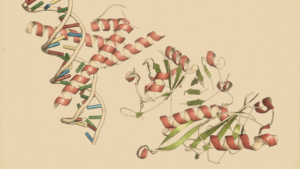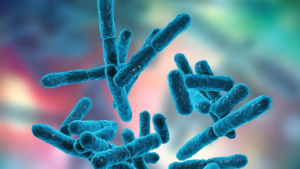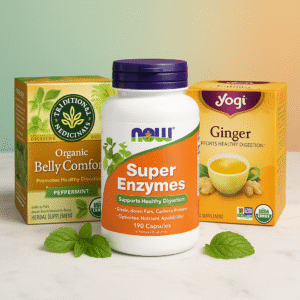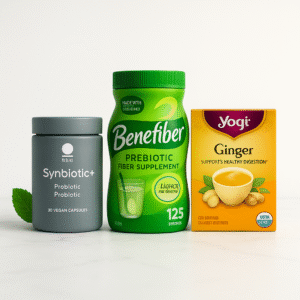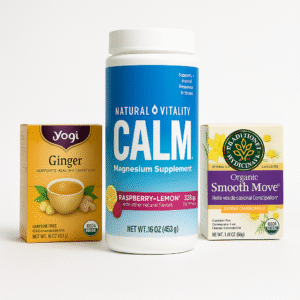Postbiotics 101: The Unsung Heroes of Immune Boosting
Step into the world of postbiotics. Uncover their pivotal role in enhancing immunity and promoting gut balance.

Key Points
- Introduction to Postbiotics:
- Postbiotics are non-living microbial byproducts that offer various health benefits. They strengthen our immune system, maintain gut health, and have potential against diseases including SARS-CoV-2.
- Unlike live bacteria, they do not pose risks of unwanted bacterial invasion in the bloodstream, making them safe for vulnerable groups like children and those with weaker immune systems.
- They have applications in both the food and beauty industries and are produced primarily through fermentation.
- Diverse Health Impacts:
- Every individual has a unique gut microbiota influenced by genetics and the environment. While the benefits of gut bacteria traditionally focus on living organisms, non-viable bacterial components (postbiotics) have emerged as beneficial.
- Postbiotics include a variety of antimicrobial compounds and demonstrate stability in production and storage. They influence immune responses, modulate microbiota, enhance gut barriers, and even interact with the nervous system.
- Defining and Exploring Postbiotics:
- Experts have worked on defining postbiotics as inanimate microorganisms or their components that provide health benefits.
- These postbiotics not only benefit gut health but have shown potential in modulating the immune system, fighting harmful microbes, and even showing anti-cancer activities. Certain foods, especially fermented ones, can boost postbiotic levels in our bodies.
- The Composition and Production of Postbiotics:
- The human gastrointestinal tract houses a vast number of microbes, and while living microbes offer benefits, their by-products, postbiotics, also play a significant role in health.
- Derived from various components like cell fragments, fatty acids, and enzymes, postbiotics are produced during processes like food processing or advanced laboratory techniques. They offer advantages like stability and safety compared to probiotics.
- Diverse Components and Benefits:
- Postbiotics come in various forms including bacterial lysates, bioactive metabolites, neurotransmitters, and exopolysaccharides (EPS).
- These compounds have a myriad of health benefits, ranging from combating inflammatory conditions, and offering potential in cancer treatments, to providing skincare benefits.
- Gut bacteria produce essential compounds, including vitamins and neurotransmitters that play a vital role in human health.
In This Article:
The Power of Postbiotics
Postbiotics are byproducts from non-living microbes.
These compounds benefit our health by strengthening our immune system, preventing harmful pathogen growth, and maintaining gut health.
They also show promise against diseases, including viruses like SARS-CoV-2.
Unlike live bacteria, postbiotics are safer with no risk of unwanted bacteria entering our bloodstream.
They're especially useful for those with weaker immune systems, young children, and infants. In the food and beauty industries, they enhance nutrition and improve skin health.
Produced through methods like fermentation, it's crucial to ensure their quality and safety.
While newer than pre- and pro-biotics, postbiotics hold immense potential for our well-being.

Postbiotics: The Future of Gut Health
Each individual has a unique set of microbiota shaped by their genetics and environment, starting from birth A Trusted Source Ursell, L. K., Metcalf, J. L., Parfrey, L. W., and Knight, R. (2012). Defining the human microbiome.Nutr. Rev.70, S38–S44. doi: 10.1111/j.1753-4887.2012.00493.x PubMed AbstractCrossRef Full TextGoogle Scholar .
While many health benefits of gut bacteria depend on their viability, recent findings suggest that even non-viable bacteria components can be beneficial.
This has led to a focus on "postbiotics"—non-living microorganisms and their byproducts that offer health advantages A Trusted Source Salminen, S., Collado, M. C., Endo, A., Hill, C., Lebeer, S., Quigley, E. M. M., et al. (2021). The International Scientific Association of Probiotics and Prebiotics (ISAPP) consensus statement on the definition and scope of postbiotics.Nat. Rev. Gastroenterol. Hepatol.18, 649–667. doi: 10.1038/s41575-021-00481-x PubMed AbstractCrossRef Full TextGoogle Scholar .
Postbiotics include diverse antimicrobial compounds, both low and high molecular weight.
Lactobacillus, a type of Lactic acid bacteria, is a key player in postbiotic production.
One notable advantage of postbiotics is their stability in production and storage.
Since they can't replicate, they pose fewer risks than probiotics, avoiding issues like harmful bacterial growth A Trusted Source Yelin, I., Flett, K. B., Merakou, C., Mehrotra, P., Stam, J., Snesrud, E., et al. (2019). Genomic and epidemiological evidence of bacterial transmission from probiotic capsule to blood in ICU patients.Nat. Med.25, 1728–1732. doi: 10.1038/s41591-019-0626-9 PubMed AbstractCrossRef Full TextGoogle Scholar .
How postbiotics work is fascinating.
They modulate resident microbiota, enhance gut barrier functions, influence immune responses, and even interact with the nervous system.
The potential applications of postbiotics are vast, from treating conditions like diabetes to food preservation and skin health.
However, as the field is emerging, a clear definition and consensus on postbiotics are needed.
Their exact mechanisms, clinical benefits, and potential applications in therapy and food industries are exciting areas of ongoing research.

Unlocking the Potential of Postbiotics
In 2019, a group of experts from varied disciplines gathered under ISAPP to pinpoint what "postbiotics" really are A Trusted Source Salminen, S., Collado, M. C., Endo, A., Hill, C., Lebeer, S., Quigley, E. M. M., et al. (2021). The International Scientific Association of Probiotics and Prebiotics (ISAPP) consensus statement on the definition and scope of postbiotics.Nat. Rev. Gastroenterol. Hepatol.18, 649–667. doi: 10.1038/s41575-021-00481-x PubMed AbstractCrossRef Full TextGoogle Scholar .
They defined postbiotics as inanimate microorganisms or their components that provide health benefits.
Unlike probiotics, which are live bacteria, postbiotics consist of these microbes in an inactivated state, often containing health-promoting metabolites or cellular components.
These benefits aren't just limited to gut health.
Postbiotics have shown potential in areas like immune system modulation, combating harmful microbes, and even anti-cancer activities.
They can reduce inflammation, oxidative stress, and other health markers like blood pressure and cholesterol.
However, caution is needed for certain groups like those with recent surgeries, heart disorders, digestive issues, expectant mothers, and children due to potential risks.
Interestingly, certain foods can boost postbiotic levels in our system.
This includes fermented products like yogurt, buttermilk, and even high-fiber foods like oats. However, the efficacy of postbiotics can be influenced by various factors.
Internal aspects, like enzymes and other food components, might inhibit their functions A Trusted Source Rad, A. H., Abbasi, A., Kafil, H. S., and Ganbarov, K. (2020). Potential pharmaceutical and food applications of postbiotics: a review.Curr. Pharm. Biotechnol.21, 1576–1587. doi: 10.2174/1389201021666200516154833 PubMed AbstractCrossRef Full TextGoogle Scholar .
For example, certain enzymes, like pepsin and trypsin, can interfere with postbiotic activity.
Externally, factors like the pH level of foods and temperature during storage or preparation play roles too A Trusted Source Moradi, M., Kousheh, S. A., Almasi, H., Alizadeh, A., Guimarães, J. T., Yilmaz, N., et al. (2020). Postbiotics produced by lactic acid bacteria: the next frontier in food safety.Compr. Rev. Food Sci. Food Safety.19, 3390–3415. doi: 10.1111/1541-4337.12613 PubMed AbstractCrossRef Full TextGoogle Scholar .
Even though the study of postbiotics is newer compared to their prebiotic and probiotic counterparts, they offer clear advantages: they're pure, stable, and can be mass-produced with precision.
As research continues, the role of postbiotics in shaping health, nutrition, and disease management is set to expand.
Postbiotics Components: A Glimpse into Gut Health & Beyond
Inside every human's gastrointestinal tract, there are trillions of microbes with over 3 million genes, most densely populated in the large intestine A Trusted Source Belizário, J. E., and Napolitano, M. (2015). Human microbiomes and their roles in dysbiosis, common diseases, and novel therapeutic approaches.Front. Microbiol.6, 1050. doi: 10.3389/fmicb.2015.01050 PubMed AbstractCrossRef Full TextGoogle Scholar .
This unique community, known as the microbiome, starts forming in the fetus and is crucial for our development A Trusted Source Tanaka, M., and Nakayama, J. (2017). Development of the gut microbiota in infancy and its impact on health in later life.Allergol. Int.66, 515–522. doi: 10.1016/j.alit.2017.07.010 PubMed AbstractCrossRef Full TextGoogle Scholar .
While it houses both helpful and harmful microbes, it's essential for this balance to remain.
An imbalance, termed dysbiosis, can lead to multiple health issues, ranging from gut problems to psychiatric disturbances A Trusted Source Carding, S., Verbeke, K., Vipond, D. T., Corfe, B. M., and Owen, L. J. (2015). Dysbiosis of the gut microbiota in disease.Microbial Ecol. Health Dis.26. doi: 10.3402/mehd.v26.26191 PubMed AbstractCrossRef Full TextGoogle Scholar .
Interestingly, it's not always the living microbes offering health benefits.
In many cases, it's their by-products - termed postbiotics.
Unlike pre- and probiotics, postbiotics come with reduced risks and are increasingly seen as a way to restore our gut balance A Trusted Source De Marco, S., Sichetti, M., Muradyan, D., Piccioni, M., Traina, G., Pagiotti, R., et al. (2018). Probiotic cell-free supernatants exhibited anti-inflammatory and antioxidant activity on human gut epithelial cells and macrophages stimulated with LPS.Evid. Based Comp. Altern. Med.2018, 1–12. doi: 10.1155/2018/1756308 PubMed AbstractCrossRef Full TextGoogle Scholar .
Postbiotics are derived from things like cell fragments, fatty acids, enzymes, and more, and are produced in various ways, such as during food processing or even in labs using techniques like sonication A Trusted Source Wegh, C. A., Geerlings, S. Y., Knol, J., Roeselers, G., and Belzer, C. (2019). Postbiotics and their potential applications in early life nutrition and beyond.Int. J. Mol. Sci.20, 4673. doi: 10.3390/ijms20194673 PubMed AbstractCrossRef Full TextGoogle Scholar .
Although probiotics, like the yeast Saccharomyces cerevisiae var. boulardii, have made their way into many foods, there's a rising interest in postbiotic versions, which offer benefits like longer shelf life and enhanced safety A Trusted Source Chan, M. Z. A., and Liu, S.-Q. (2022). Fortifying foods with synbiotic and postbiotic preparations of the probiotic yeast,Saccharomyces boulardii.Curr. Opin. Food Sci.43, 216–224. doi: 10.1016/j.cofs.2021.12.009 CrossRef Full TextGoogle Scholar .
Cutting-edge research is diving deep into postbiotics, using advanced tech to understand them better for potential therapeutic uses A Trusted Source Pyclik, M., Srutkova, D., Schwarzer, M., and Górska, S. (2020). Bifidobacteria cell wall-derived exo-polysaccharides, lipoteichoic acids, peptidoglycans, polar lipids and proteins – their chemical structure and biological attributes.Int. J. Biol. Macromol.147, 333–349. doi: 10.1016/j.ijbiomac.2019.12.227 PubMed AbstractCrossRef Full TextGoogle Scholar .
Some postbiotic products, like Lacteol, are already commercially available and used for health benefits A Trusted Source Barros, C. P., Guimarães, J. T., Esmerino, E. A., Duarte, M. C. K., Silva, M. C., Silva, R., et al. (2020). Paraprobiotics and postbiotics: concepts and potential applications in dairy products.Curr. Opin. Food Sci.32, 1–8. doi: 10.1016/j.cofs.2019.12.003 PubMed AbstractCrossRef Full TextGoogle Scholar .

A significant advantage of postbiotics over probiotics is their stability; they don't require the same rigorous storage conditions, blending well with food without changing taste, and proving safe for vulnerable groups.
They function in diverse ways, influencing various body systems through pathways like the Gut-brain and Gut-lung axes A Trusted Source Nataraj, B. H., Ali, S. A., Behare, P. V., and Yadav, H. (2020). Postbiotics-parabiotics: the new horizons in microbial biotherapy and functional foods.Microb. Cell Fact.19. doi: 10.1186/s12934-020-01426-w PubMed AbstractCrossRef Full TextGoogle Scholar .
Non-Living Probiotics
Various methods, including heat and radiation, produce non-viable probiotics.
Despite their inactivation, these cells maintain key biological activities similar to living probiotics, such as reducing inflammation and interacting with specific pathogens A Trusted Source Sugahara, H., Yao, R., Odamaki, T., and Xiao, J. Z. (2017). Differences between live and heat-killed bifidobacteria in the regulation of immune function and the intestinal environment.Benef. Microbes8, 463–472. doi: 10.3920/BM2016.0158 PubMed AbstractCrossRef Full TextGoogle Scholar .
Cell-Free Suspensions in Health
Microbes produce beneficial compounds, which, when separated from their cells, contain valuable antioxidants and anti-inflammatory agents A Trusted Source Hamad, G. M., Abdelmotilib, N. M., Darwish, A. M. G., and Zeitoun, A. M. (2020). Commercial probiotic cell-free supernatants for inhibition ofClostridium perfringenspoultry meat infection in Egypt.Anaerobe62, 102181. doi: 10.1016/j.anaerobe.2020.102181PubMed AbstractCrossRef Full TextGoogle Scholar .
For instance, Lactobacillus fermentum's cell-free culture can potentially combat colorectal cancer A Trusted Source Lee, J., Lee, J.-E., Kim, S., Kang, D., and Yoo, H. M. (2020). Evaluating cell death using cell-free supernatant of probiotics in three-dimensional spheroid cultures of colorectal cancer cells.J. Vis. Exp. doi: 10.3791/61285 PubMed AbstractCrossRef Full TextGoogle Scholar .
Moreover, Lactobacillus reuten's filtrate has been suggested to fight dental diseases A Trusted Source Yang, K. M., Kim, J.-S., Kim, H.-S., Kim, Y.-Y., Oh, J.-K., Jung, H.-W., et al. (2021). Lactobacillus reuteri AN417 cell-free culture supernatant as a novel antibacterial agent targeting oral pathogenic bacteria.Sci. Rep.11. doi: 10.1038/s41598-020-80921-x PubMed AbstractCrossRef Full TextGoogle Scholar .
A notable study also found that probiotic strains could suppress harmful bacteria in poultry meat, hinting at its future role in food safety.
These suspensions, particularly from Lactobacillus and Pediococcus species, contain compounds that combat harmful microbes like Staphylococcus aureus and E. coli by disrupting their cell structures A Trusted Source George-Okafor, U., Ozoani, U., Tasie, F., and Mba-Omeje, K. (2020). The efficacy of cell-free supernatants fromLactobacillus plantarumCs andLactobacillus acidophilusATCC 314 for the preservation of home-processed tomato-paste.Sci. Afr.8, e00395. doi: 10.1016/j.sciaf.2020.e00395 CrossRef Full TextGoogle Scholar .
Additionally, the Weissella cibaria probiotic strain has demonstrated its ability to battle gum disease-causing bacteria A Trusted Source Lim, H.-S., Yeu, J.-E., Hong, S.-P., and Kang, M.-S. (2018). Characterization of antibacterial cell-free supernatant from oral care probiotic Weissella cibaria, CMU.Molecules23, 1984. doi: 10.3390/molecules23081984 PubMed AbstractCrossRef Full TextGoogle Scholar .
Compared to isolated compounds, these suspensions often have a more profound effect on health due to a synergy of their bioactive molecules A Trusted Source Hartmann, H. A., Wilke, T., and Erdmann, R. (2011). Efficacy of bacteriocin-containing cell-free culture supernatants from lactic acid bacteria to control Listeria monocytogenes in food.Int. J. Food Microbiol.146, 192–199. doi: 10.1016/j.ijfoodmicro.2011.02.031 PubMed AbstractCrossRef Full TextGoogle Scholar .
When studied, certain lactobacilli strains presented a range of beneficial compounds, including antioxidants and agents that can remove harmful biofilms (Moradi et al., 2020).
One specific suspension, from Enterococcus faecalis, even showcased its potential for food preservation A Trusted Source de Las M Cardoso, M., Manzo, R.M., Tonarelli, G.G., and Simonetta, A.C. (2012). Characterisation of a cell-free supernatant obtained from cultures ofEnterococcus faecalisDBFIQ E24 with antagonistic activity against bacteria, yeasts and moulds.Int. J. Dairy Technol.65, 568–577. doi: 10.1111/j.1471-0307.2012.00852.x CrossRef Full TextGoogle Scholar .
Exopolysaccharides
Exopolysaccharides (EPS) are complex sugars produced by microbes such as Lactobacilli A Trusted Source Caggianiello, G., Kleerebezem, M., and Spano, G. (2016). Exopolysaccharides produced by lactic acid bacteria: from health-promoting benefits to stress tolerance mechanisms.Appl. Microbiol. Biotechnol.100, 3877–3886. doi: 10.1007/s00253-016-7471-2 PubMed AbstractCrossRef Full TextGoogle Scholar .
These molecules serve dual purposes: protecting the microorganisms and positively impacting human health.
For instance, specific EPS from Lactobacillus has been shown to balance inflammation in the body by both reducing pro-inflammatory agents and boosting anti-inflammatory ones A Trusted Source Dinić, M., Pecikoza, U., Djokić, J., Stepanović-Petrović, R., Milenković, M., Stevanović, M., et al (2018) Exopolysaccharide produced by probiotic strain lactobacillus paraplantarum bgcg11 reduces inflammatory hyperalgesia in rats.Front. Pharmacol. 9, 1. doi: 10.3389/fphar.2018.00001.PubMed AbstractCrossRef Full TextGoogle Scholar .
Other findings reveal that EPS might offer benefits against diseases like diabetes, rheumatoid arthritis, and even certain cancers by inhibiting harmful biofilm formation and exhibiting antioxidant properties A Trusted Source Wang, K., Niu, M., Song, D., Song, X., Zhao, J., Wu, Y., et al. (2020). Preparation, partial characterization and biological activity of exopolysaccharides produced from Lactobacillus fermentum S1.J. Biosci. Bioeng.129, 206–214. doi: 10.1016/j.jbiosc.2019.07.009 PubMed AbstractCrossRef Full TextGoogle Scholar .
Beyond health, EPS from some bacteria find versatile applications in industries ranging from food to textiles, with some already utilized as food additives A Trusted Source Angelin, J., and Kavitha, M. (2020). Exopolysaccharides from probiotic bacteria and their health potential.Int. J. Biol. Macromol.162, 853–865. doi: 10.1016/j.ijbiomac.2020.06.190 PubMed AbstractCrossRef Full TextGoogle Scholar .
Extraction of EPS is a meticulous process that results in varied structures depending on their source, influencing their biological effects A Trusted Source Jurášková, D., Ribeiro, S. C., and Silva, C. C. G. (2022). Exopolysaccharides produced by lactic acid bacteria: from biosynthesis to health-promoting properties.Foods11, 156. doi: 10.3390/foods11020156 PubMed AbstractCrossRef Full TextGoogle Scholar .
Separately, extracellular vesicles (EVs) are tiny structures released by bacteria. Packed with a variety of compounds, they play vital roles in maintaining gut health, regulating lipid metabolism, and facilitating communication within the body A Trusted Source Ahmadi Badi, S., Moshiri, A., Fateh, A., Rahimi Jamnani, F., Sarshar, M., Vaziri, F., et al. (2017). Microbiota-derived extracellular vesicles as new systemic regulators.Front. Microbiol.8, 1610. doi: 10.3389/fmicb.2017.01610 PubMed AbstractCrossRef Full TextGoogle Scholar .

Bacterial Cell Walls
Bacterial cell walls are intricate structures primarily composed of lipopolysaccharide in Gram-negative bacteria and peptidoglycan in both Gram-positive and Gram-negative bacteria A Trusted Source Schaefer, A. K., Melnyk, J. E., He, Z., Del Rosario, F., and Grimes, C. L. (2018). Pathogen- and microbial- associated molecular patterns (PAMPs/MAMPs) and the innate immune response in crohn's disease.Immun. Inflamm. Health Dis.11, 175–187. doi: 10.1016/B978-0-12-805417-8.00014-7 CrossRef Full TextGoogle Scholar .
A significant component of the Gram-positive cell wall is peptidoglycan, which can constitute up to 70% of it.
This structure also contains teichoic acids, unique to Gram-positive bacteria, and divided into wall teichoic acid and lipo teichoic acids A Trusted Source Swoboda, J. G., Campbell, J., Meredith, T. C., and Walker, S. (2009). Wall teichoic acid function, biosynthesis, and inhibition.Chembiochem11, 35–45. doi: 10.1002/cbic.200900557 PubMed AbstractCrossRef Full TextGoogle Scholar .
These components play a pivotal role in host signaling and adhesion A Trusted Source Pyclik, M., Srutkova, D., Schwarzer, M., and Górska, S. (2020). Bifidobacteria cell wall-derived exo-polysaccharides, lipoteichoic acids, peptidoglycans, polar lipids and proteins – their chemical structure and biological attributes.Int. J. Biol. Macromol.147, 333–349. doi: 10.1016/j.ijbiomac.2019.12.227 PubMed AbstractCrossRef Full TextGoogle Scholar .
When these cell wall components interact with our immune system, they can stimulate the release of cytokines.
However, an excessive release may lead to severe complications like septic shock A Trusted Source Hamann, L. E. L.-, Samalouti, V., Ulmer, A. J., Flad, H.-D., and Rietschel, E.T. (1998). Components of gut bacteria as immunomodulators.Int. J. Food Microbiol.41, 141–154. doi: 10.1016/S0168-1605(98)00047-6 PubMed AbstractCrossRef Full TextGoogle Scholar .
Research also suggests that specific components like the proteins p75 and p40 from Lactobacillus rhamnosus protect the gut lining A Trusted Source Yan, F., Cao, H., Cover, T. L., Whitehead, R., Washington, M. K., and Polk, D. B. (2007). Soluble proteins produced by probiotic bacteria regulate intestinal epithelial cell survival and growth.Gastroenterology132, 562–575. doi: 10.1053/j.gastro.2006.11.022 PubMed AbstractCrossRef Full TextGoogle Scholar .
Additionally, teichoic acid has shown potential anticancer properties, particularly against liver cancer cells A Trusted Source Guo, B., Xie, N., and Wang, Y. (2015). Cooperative effect of Bifidobacteria lipoteichoic acid combined with 5-fluorouracil on hepatoma-22 cells growth and apoptosis.Bull. Cancer102, 204–212. doi: 10.1016/j.bulcan.2014.09.003 PubMed AbstractCrossRef Full TextGoogle Scholar .
On the other hand, bacterial pili, long extensions on bacterial surfaces, have been noted for their importance in adhering to the intestinal wall and influencing the infant immune system A Trusted Source Bach, J.-F. (2002). The effect of infections on susceptibility to autoimmune and allergic diseases.N. Engl. J. Med.347, 911–920. doi: 10.1056/NEJMra020100 PubMed AbstractCrossRef Full TextGoogle Scholar .
Bacterial Lysates
Bacterial lysates, created by breaking down bacterial cells, offer a myriad of health advantages.
Studies have shown their potential in combating inflammatory conditions like ulcerative colitis.
Specifically, lysates from Lactobacillus caseii can prevent inflammatory bowel diseases, potentially by balancing the gut's bacterial composition, reinforcing the intestinal barrier, and regulating immune responses A Trusted Source Russo, E., Giudici, F., Fiorindi, C., Ficari, F., Scaringi, S., and Amedei, A. (2019). Immunomodulating activity and therapeutic effects of short chain fatty acids and tryptophan post-biotics in inflammatory bowel disease.Front. Immunol.10, 2754. doi: 10.3389/fimmu.2019.02754 PubMed AbstractCrossRef Full TextGoogle Scholar .
A notable observation from Mi A Trusted Source Mi, X.-J., Tran, T. H. M., Park, H.-R., Xu, X. Y., Subramaniyam, S., Choi, H. S., et al. (2022). Immune-enhancing effects of postbiotic produced by Bacillus velezensis Kh2-2 isolated from Korea Foods.Food Res. Int.152, 110911. doi: 10.1016/j.foodres.2021.110911 PubMed AbstractCrossRef Full TextGoogle Scholar revealed that lysates from Bacillus velezensis, found in a Korean fermented food, boost immune activity.
Furthermore, lysates from probiotics like Lactobacillus acidophilus and Bifidobacterium longum have been associated with increased bone mineral density, suggesting their potential role in osteoporosis treatment A Trusted Source Montazeri-Najafabady, N., Ghasemi, Y., Dabbaghmanesh, M. H., Ashoori, Y., Talezadeh, P., Koohpeyma, F., et al. (2021). Exploring the bone sparing effects of postbiotics in the post-menopausal rat model.BMC Compl. Med. Ther.21. doi: 10.1186/s12906-021-03327-w PubMed AbstractCrossRef Full TextGoogle Scholar .
Bifidobacterium longum lysate has also shown promising results in managing reactive skin conditions A Trusted Source Guéniche, A., Bastien, P., Ovigne, J. M., Kermici, M., Courchay, G., Chevalier, V., et al. (2009). Bifidobacterium longum lysate, a new ingredient for reactive skin.Exp. Dermatol.19, e1–e8. doi: 10.1111/j.1600-0625.2009.00932.x PubMed AbstractCrossRef Full TextGoogle Scholar .
Due to their potential skin benefits, many skincare brands have started including bacterial lysates in their products A Trusted Source Khmaladze, I., Butler, É., Fabre, S., and Gillbro, J. M. (2019). Lactobacillus reuteri DSM 17938—A comparative study on the effect of probiotics and lysates on human skin.Exp. Dermatol.28, 822–828. doi: 10.1111/exd.13950 PubMed AbstractCrossRef Full TextGoogle Scholar .
Additionally, lysates from specific Lactobacillus species have demonstrated an ability to suppress colorectal tumor cell growth A Trusted Source Dallal, M. M. S., Mojarrad, M., Baghbani, F., Raoofian, R., Mardaneh, J., and Salehipour, Z. (2015). Effects of probiotic Lactobacillus acidophilus and Lactobacillus casei on colorectal tumor cells activity (CaCo-2).Arch. Iran. Med.18, 167–172.PubMed AbstractGoogle Scholar .
Enhanced immune response in cancer patients has also been linked to heat-shocked lysates of L. plantarum, likely due to increased heat-shock proteins A Trusted Source Sanaei, M., Mahdavi, M., Setayesh, N., Shahverdi, A. R., Sepehrizadeh, Z., and Yazdi, M. H. (2021). Comparison of cytokine expression in human PBMCs stimulated with normal and heat-shocked lactobacillus plantarum cell lysate.Probiotics Antimicrob. Proteins13, 1539–1545. doi: 10.1007/s12602-021-09785-5 PubMed AbstractCrossRef Full TextGoogle Scholar .
Bioactive metabolites
Beneficial gut microbes produce substances crucial for health.
Amiri highlighted how waste like cheese whey can be used for producing vital metabolites such as CLA, EPSs, and BACs by Bifidobacterium lactis A Trusted Source Amiri, S., Rezazadeh-Bari, M., Alizadeh-Khaledabad, M., Rezaei-Mokarram, R., and Sowti-Khiabani, M. (2021). Fermentation optimization for co-production of postbiotics byBifidobacterium lactisBB12 in cheese whey.Waste Biomass Valoriza.12, 5869–5884. doi: 10.1007/s12649-021-01429-7 CrossRef Full TextGoogle Scholar .
To understand these metabolites, advanced techniques, such as HPLC and NMR, are employed A Trusted Source Moradi, M., Kousheh, S. A., Almasi, H., Alizadeh, A., Guimarães, J. T., Yilmaz, N., et al. (2020). Postbiotics produced by lactic acid bacteria: the next frontier in food safety.Compr. Rev. Food Sci. Food Safety.19, 3390–3415. doi: 10.1111/1541-4337.12613 PubMed AbstractCrossRef Full TextGoogle Scholar .
Their composition varies based on microbial strains and culture conditions, emphasizing the importance of optimal fermentation settings.
Vitamins
Vitamins are essential compounds our bodies can't produce on their own.
While we usually think of foods like spinach or oranges as our primary vitamin sources, did you know our gut bacteria also play a role?
The gut is home to friendly bacteria like lactic acid bacteria and Bifidobacterium sp. that produce vitamins vital for our health, such as vitamin K and certain B vitamins.
These nutrients can be found abundantly in fermented foods like yogurt A Trusted Source LeBlanc, J. G., Milani, C., de Giori, G. S., Sesma, F., van Sinderen, D., and Ventura, M. (2013). Bacteria as vitamin suppliers to their host: a gut microbiota perspective.Curr. Opin. Biotechnol.24, 160–168. doi: 10.1016/j.copbio.2012.08.005 PubMed AbstractCrossRef Full TextGoogle Scholar .
Neurotransmitters
These chemical messengers, including serotonin and dopamine, affect our brain's function.
Fascinatingly, gut bacteria are responsible for producing some of these compounds, impacting our mood and even memory A Trusted Source Patterson, E., Cryan, J. F., Fitzgerald, G. F., Ross, R. P., Dinan, T. G., and Stanton, C. (2014). Gut microbiota, the pharmabiotics they produce and host health.Proc. Nutr. Soc.73, 477–489. doi: 10.1017/S0029665114001426 PubMed AbstractCrossRef Full TextGoogle Scholar .
Biosurfactants
These compounds are made by microbes and act against harmful bacteria.
By disrupting harmful bacteria's cellular structures, biosurfactants prevent infections and diseases A Trusted Source Cameotra, S. S., and Makkar, R. S. (2010). Biosurfactant-enhanced bioremediation of hydrophobic pollutants.Pure Appl. Chem.82, 97–116. doi: 10.1351/PAC-CON-09-02-10 CrossRef Full TextGoogle Scholar .
Short Chain Fatty Acids (SCFs)
SCFs, produced from indigestible carbs by bacteria like Bacteroides, have numerous health benefits.
They support gut health, regulate colon functions, and even offer protection against certain diseases A Trusted Source Rowland, I., Gibson, G., Heinken, A., Scott, K., Swann, J., Thiele, I., et al. (2017). Gut microbiota functions: metabolism of nutrients and other food components.Eur. J. Nutr.57, 1–24. doi: 10.1007/s00394-017-1445-8 PubMed AbstractCrossRef Full TextGoogle Scholar .
Bacteriocins
These are proteins made by certain bacteria that can kill or inhibit the growth of other harmful bacteria.
Their potential in food preservation is remarkable.
For instance, nisin, a bacteriocin, has been approved by regulatory authorities for food preservation A Trusted Source Negash, A. W., and Tsehai, B. A. (2020). Current applications of bacteriocin.Int. J. Microbiol.2020, 1–7. doi: 10.1155/2020/4374891 PubMed AbstractCrossRef Full TextGoogle Scholar .
Researchers are also studying bacteriocins for their antimicrobial, anticancer, and antiviral properties (Soltani et al., 2020).
Hydrogen Peroxide
This compound, made by specific bacteria, helps combat diseases and improves gut health conditions.
For instance, studies have suggested that it can be effective against certain pathogens and might even offer protection against viruses like SARS-2 COVID by enhancing the immune response A Trusted Source Caruso, A. A., Del Prete, A., and Lazzarino, A. I. (2020). Hydrogen peroxide and viral infections: a literature review with research hypothesis definition in relation to the current covid-19 pandemic.Med. Hypotheses144, 109910. doi: 10.1016/j.mehy.2020.109910PubMed AbstractCrossRef Full TextGoogle Scholar .
In summary, the microorganisms living within us don't just help digest our food.
They play a significant role in our overall health by producing a range of vital compounds.
Recognizing and harnessing this potential could lead to groundbreaking therapies and treatments in the future.
Discussion
Postbiotics have emerged as a promising frontier in the vast landscape of gut health, wellness, and disease prevention.
Their intriguing nature, being non-viable by-products of microbial activity, offers a unique perspective on harnessing the benefits of microbial action without the challenges posed by living organisms.
As we navigate through the multi-faceted realm of postbiotics, a few key observations become apparent:
- Diverse Benefits: From modulating the immune system to counteracting harmful pathogens and potential applications in disease management such as diabetes and skin health, postbiotics present a plethora of potential health advantages. Their role is not confined to gut health; they exhibit systemic influences, including interactions with the nervous system.
- Safety and Stability: Unlike probiotics, postbiotics don’t pose risks of unwanted bacterial growth. Their inability to replicate reduces the risks of imbalances in the microbial ecosystem of the host. Additionally, their stable nature makes them amenable to varied applications, particularly in the food and cosmetics industry.
- Complexity and Variation: The term “postbiotics” encompasses a vast array of compounds, ranging from cell-free suspensions to bacterial lysates and bioactive metabolites. Each carries its unique set of properties, influenced by factors like the source of microbes, extraction or production processes, and storage conditions.
- Potential in Therapeutics and Industry: While many postbiotic components, like exopolysaccharides and bacterial lysates, have showcased potential therapeutic uses, their industrial applications are also noteworthy. The cosmetics sector and food preservation are just the tip of the iceberg.
Conclusion
Postbiotics marks a significant stride in our ongoing journey to comprehend and harness the might of the microbiome for holistic health and well-being.
Their vast array of components, from antimicrobial agents to neurotransmitters, showcases the depth and breadth of their potential.
While they offer notable advantages in terms of stability and safety, especially for vulnerable populations, it’s crucial that the scientific community continues its rigorous research to delineate their exact mechanisms, long-term effects, and optimal application methodologies.
Furthermore, as the awareness and popularity of postbiotics grow, it becomes imperative for regulators and stakeholders to establish clear definitions, quality standards, and usage guidelines.
This will not only ensure the safe and effective use of postbiotics but also cement their position as a cornerstone in the next generation of health and wellness solutions.
Lastly, the inherent link between diet, particularly fermented foods, and postbiotic levels in our system underscores the timeless wisdom of traditional dietary practices.
As we step into the future, it's with a nod to the past, acknowledging once more that sometimes, the best solutions lie in nature's lap, waiting to be discovered and understood.
Review date not set.
How we reviewed this article:
Latest on:
